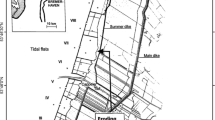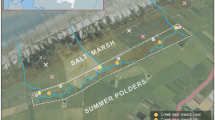Abstract
As a result of the construction of a storm-surge barrier across the mouth of the Oosterschelde (SW Netherlands) in 1987, the tidal range and mean high water level in the estuary have been reduced permanently to about 88% of their original values. During the final stage of construction (1985–1987) the tidal range and mean high water level were reduced even further for more than 18 months, by up to about 65% of their original values. This paper describes the consequences of these reductions for some abiotic aspects of the salt marshes.
Strong ripening of the soil, especially in basins of the middle high salt marshes, resulted in the soils in these basins having more or less the dry nature of levees. This may cause moisture deficits for the vegetation during dry periods locally, and may lead locally to acidification of the soil as a result of oxidation of pyrite.
Erosion of the edges of the salt marshes has increased in many places since 1986, both due to lowering of the surface level of the foreland, causing wave action to affect the marsh cliff more strongly than before, and weakening of cliff strength as a consequence of desiccation of the salt marsh soil and subsequent withering of plants and plant roots. In addition, the gradual salt marsh gradients have decreased on a large scale, as a consequence of increased wave attack and frost damage to Spartina. Finally, also due to desiccation and plant withering, levees have degraded and eroded, forming shoulders in the creeks.
Settling, especially in the basins, has steepened and narrowed the height gradients between basin and levee.
Similar content being viewed by others
References
Adam, P., 1990. Saltmarsh Ecology. Cambridge Studies in Ecology, Cambridge University Press; ISBN 0-521-24508-7 (461 pp).
Beeftink, W. G., 1965. De zoutvegetatie van zuidwest Nederland beschouwd in europees verband (Salt marsh communities of the SW-Netherlands in relation to the European halophytic vegetation, in Dutch), thesis. Mededelingen Landbouwhogeschool 65–1, Wageningen (167 pp).
Beeftink, W. G., 1979. The structure of salt marsh communities in relation to environmental disturbances. In: Jefferies, R. L. & A. J. Davy (eds), Ecological processes in coastal environments. Blackwell, Oxford: 77–93.
De Jong, D. J. & Z. de Jong, 1993. The consequences of a one-year tidal reduction of 35% for salt marshes in the Oosterschelde (SW Netherlands). Proceedings ECSA.
De Jong, D. J. & A. M. van der Pluijm, 1994. Consequences of a tidal reduction for the salt-marsh vegetation in the Oosterschelde estuary (The Netherlands). Hydrobiologia 282/283: 317–333.
De Kogel, T. J. & D. J. de Jong, 1980. Vegetatiekartering van de schorren in de Oosterschelde en het Krammer-Volkerak, 1978 (Vegetation mapping of the salt-marshes in the Oosterschelde and the Krammer-Volkerak, 1978; in Dutch). Rijkswaterstaat, Deltadienst. Nota DDMI-80.20.
De Leeuw, J., L. Apon, P. Herman, W. de Munck & W. G. Beeftink, 1994. The response of salt-marsh vegetation to tidal reduction caused by the Oosterschelde storm-surge barrier. Hydrobiologia 282/283: 335–353.
Houtekamer, N. L., 1991. Schorren in de Oosterschelde: onderzoek naar het verzuringsrisico van schorbodems door de oxidatie van pyriet (salt marshes in the Oostershelde: research into acidification risks of the salt marsh soil by oxidation of pyrite, in Dutch). State University Utrecht, Institute of Geographical Research, Report GEOPRO 1991.05 (IRO).
Long, S. P. & C. F. Mason, 1983. Saltmarsh ecology. Blackie, Glasgow; ISBN 0–216–91438–8, 160 pp.
Mulder, J. P. M. & T. Louters, 1994. Changes in basin geomorphology after implementation of the Oosterschelde estuary project. Hydrobiologia 282/283: 29–39.
Nienhuis, P. H. & A. C. Smaal, 1994. The Oosterschelde estuary, a case study of a changing ecosystem: an introduction. Hydrobiologia 282/283: 1–14.
Oenema, O., 1988a. Pyrite accumulation in salt marshes in the Eastern Scheldt. In: Oenema, O. 1988: Early diagenesis in recent fine-grained sediments in the Eastern Scheldt. State University Utrecht, Institute of Earth Sciences, Thesis.
Oenema, O., 1988b. Distribution and cycling of fine-grained sediment in the Eastern Scheldt. In: Oenema, O., 1988: Early diagenesis in recent fine-grained sediments in the Eastern Scheldt. State University Utrecht, Institute of Earth Sciences, Thesis.
Oenema, O. & R. D. DeLaune, 1988. Accretion rates in salt marshes in the Eastern Scheldt, SW Netherlands. Estuar coast. Shelf Sci. 26: 379–395.
Pons, L. J. & I. S. Zonneveld, 1965. Soil ripening and soil classification. Int. Inst. for Land Reclamation and Improvement, publ. 13, Veenman, Wageningen, 128 pp.
Saeijs, H. L. F. & J. P. Al, 1982. Environmental impact assessment for design and management of the Oosterschelde barrier. In: Saeijs, H. L. F., Changing estuaries; State University Leiden, thesis/Rijkswaterstaat communications nr 32, Government Publishing Office, The Hague 1982. (ISBN 90–12–03921–5), 414 pp.
Schoot, P. M. & M. M. van Eerdt, 1985. Toekomstige ontwikkelingen van de schor gebieden in de Oosterschelde, procesonderzoek schorsystemen (Future developments of salt marshes in the Oosterschelde, process research on salt marsh systems; in Dutch). Rijkswaterstaat Tidal Waters Division, Report DDMI-85.23, Middelburg
Ten Brinke, W. B. M., J. Dronkers & J. P. M. Mulder, 1994. Fine sediments in the Oosterschelde tidal basin before and after partial closure. Hydrobiologia 282/283: 41–56.
Tutin, T. G., V. H. Heywood, N. A. Burges, D. M. Moore, D. H. Valentine, S. M. Walters & D. A. Webb, 1964–1980. Flora Europaea. Cambridge University Press, Cambridge. 5 Volumes.
Van Breemen, N., 1973. Soil forming processes in acid sulphate soils. Proc. Int. Symp. on Acid Sulphate Soils. Volume I. Wageningen.
Van Diggelen, J. 1988. A Comparative study on the ecophysiology of salt marsh halophytes. Thesis, Free University Press, Amsterdam. ISBN 90–6256–622–7 CIP, 208 pp.
Van Eerdt, M. J., 1985. The influence of vegetation on the processes of erosion and sedimentation in the salt marshes of the Oosterschelde. Vegetatio 62: 367–373.
Vranken, M., O. Oenema & J. P. M. Mulder, 1990. Effects of tide range alterations on salt marsh sediments in the Eastern Scheldt, SW Netherlands. Hydrobiologia 195: 13–20.
Vroon, J., 1994. Hydrodynamic characteristics of the Oosterschelde in recent decades. Hydrobiologia 282/283: 17–27.
Wetsteyn, L. P. M. J. & J. C. Kromkamp, 1994. Turbidity, nutrients and phytoplankton primary production in the Oosterschelde (The Netherlands) before, during and after a large-scale coastal engineering project (1980–1990). Hydrobiologia 282/283: 61–78.
Author information
Authors and Affiliations
Rights and permissions
About this article
Cite this article
de Jong, D.J., de Jong, Z. & Mulder, J.P.M. Changes in area, geomorphology and sediment nature of salt marshes in the Oosterschelde estuary (SW Netherlands) due to tidal changes. Hydrobiologia 282, 303–316 (1994). https://doi.org/10.1007/BF00024638
Issue Date:
DOI: https://doi.org/10.1007/BF00024638




